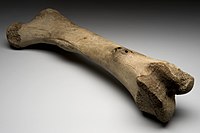
Photo from wikipedia
OBJECTIVE We aimed to investigate the relative preoperative position of the spinal cord in AIS and explore the potential risk of spinal cord injury from placement of pedicle screws. PATIENTS… Click to show full abstract
OBJECTIVE We aimed to investigate the relative preoperative position of the spinal cord in AIS and explore the potential risk of spinal cord injury from placement of pedicle screws. PATIENTS AND METHODS Twenty-seven patients with a mean age of 15 ± 1.8 years (range, 12-19 years) classified as having Lenke type 1 AIS (1A: 15 cases, 1B: 8 cases, 1C: 4 cases) were analyzed. The mean Cobb angle of the main curve was 55.9 ± 14.4°. Axial CT myelography images were selected from the T4 to T12 vertebrae, and 243 images were analyzed. Outer cortical pedicle width, inner cortical pedicle width, pedicle length, chord length, transverse pedicle angle, the angle of rotation (RAsag) of the vertebra, and the distance between the spinal cord and concave (Dc) and convex pedicles (Dv) were calculated from landmark locations. RESULTS The mean concave outer cortical pedicle width was larger than the mean convex outer cortical pedicle width at T4, T5, T11, and T12 (p < 0.05) and smaller than the mean convex outer cortical pedicle width around the apex of the curve from T7 to T9 (p < 0.05). The mean concave inner cortical pedicle width was larger than the mean convex inner cortical pedicle width at T4, T5, and T11 (p < 0.05) and smaller than the mean convex inner cortical pedicle width around the apex of the curve at T7 and T8 (p < 0.001). The mean Dc was smaller than the mean Dv around the apex of the curve from T6 to T11 (p < 0.05). Dv was significantly correlated with the convex outer cortical pedicle width (R = 0.286, p < 0.001), convex inner cortical pedicle width (R = 0.202, p = 0.002), convex transverse pedicle angle (R=-0.286, p < 0.001), and RAsag (R = 0.277, p < 0.001). Dc was significantly correlated with the concave outer (R = 0.269, p < 0.001) and inner cortical pedicle width (R = 0.230, p < 0.001). CONCLUSION The distance from the spinal cord to the medial wall of the pedicle was significantly correlated with outer and inner cortical pedicle width, and the potential risk of spinal cord injury by pedicle screw is increased with insertion into a narrower pedicle, especially on the concave side around the apex.
Journal Title: Clinical Neurology and Neurosurgery
Year Published: 2018
Link to full text (if available)
Share on Social Media: Sign Up to like & get
recommendations!